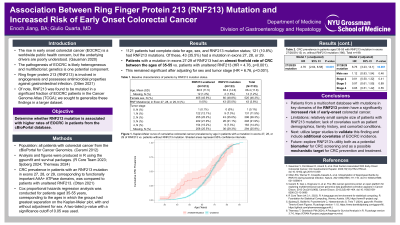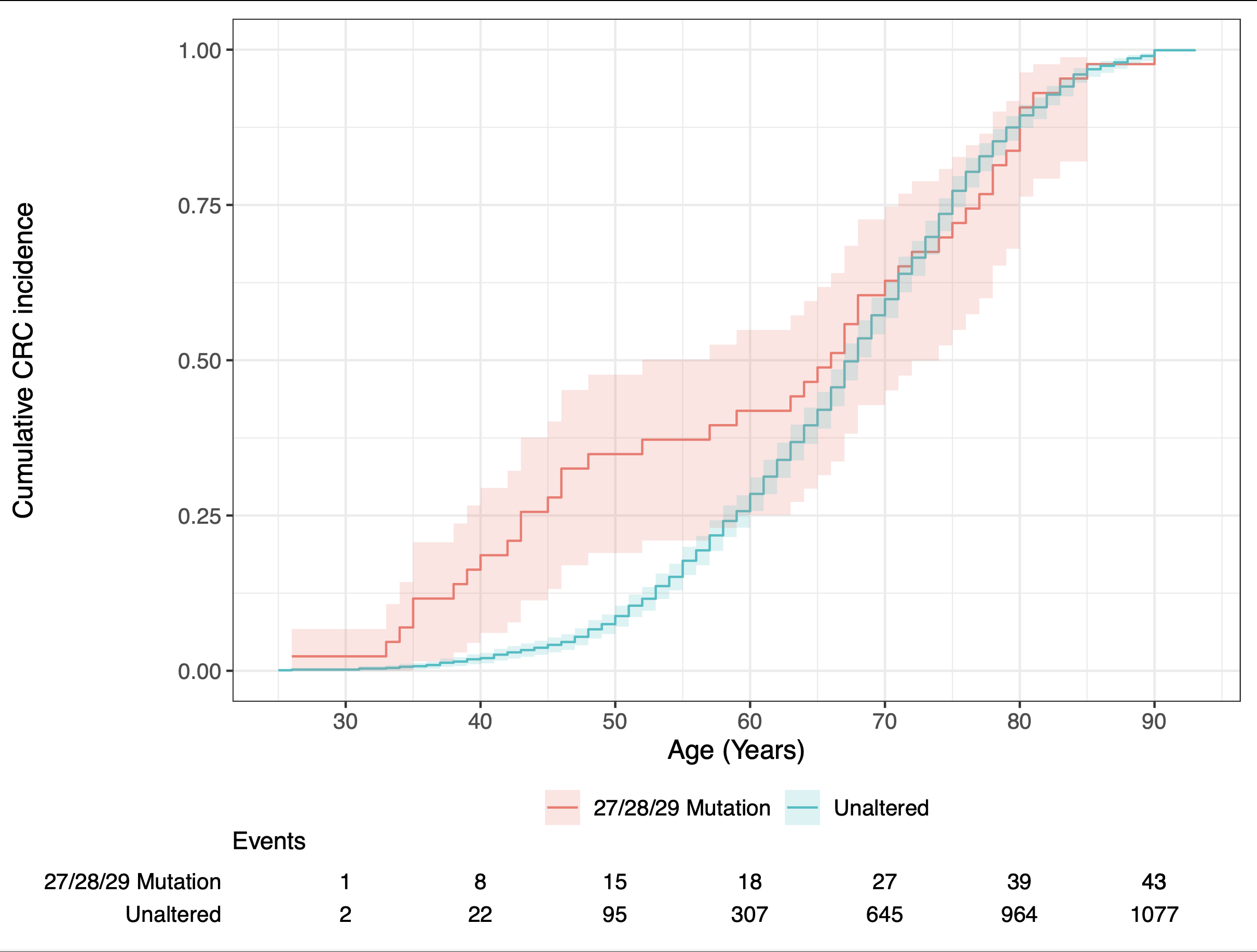Sunday Poster Session
Category: Colorectal Cancer Prevention
P0441 - Association Between Ring Finger Protein 213 (RNF213) Mutation and Increased Risk of Early Onset Colorectal Cancer
Sunday, October 27, 2024
3:30 PM - 7:00 PM ET
Location: Exhibit Hall E

Has Audio
- EJ
Enoch Jiang, BA
NYU Grossman School of Medicine
New York, NY
Presenting Author(s)
Award: Presidential Poster Award
Enoch Jiang, BA1, Giulio Quarta, MD2
1NYU Grossman School of Medicine, New York, NY; 2NYU Langone Health, Brooklyn, NY
Introduction: The rising incidence of early onset colorectal cancer (EOCRC) is a worldwide public health concern, yet the underlying drivers of this trend are poorly understood. The pathogenesis of EOCRC is likely heterogeneous and multifactorial, but genetics is one potential component. Ring finger protein 213 (RNF213) is involved in angiogenesis and has been found to possess antimicrobial properties against gastrointestinal infection. Of note, it is mutated in a significant fraction of EOCRC patients in the cBioportal for Cancer Genomics database. This study aims to determine whether RNF213 mutation is associated with EOCRC incidence using the cBioPortal database.
Methods: Data was obtained from all CRC patients in the cBioPortal for Cancer Genomics, an open-source online database compiling data from more than 350 studies globally (Cerami et al., 2012). Analysis was performed in R (v4.3.1; R Core Team, 2023) with the ggsurvfit (v1.1.0; Sjoberg et al., 2024) and survival (v3.6-4; Therneau and Grambsch, 2024) packages. CRC incidence in patients with an RNF213 mutation in exons 27, 28, or 29, corresponding to functionally important AAA+ ATPase domains, was compared to patients without mutation. Cox proportional hazards regression analysis was conducted for patients aged 35-55 years, corresponding to the ages in which the groups separated on the Kaplan-Meier plot, with and without adjustment for sex. A two-tailed p-value with a significance cutoff of 0.05 was used.
Results: 1121 patients had complete data for age, sex, and RNF213 mutation status; 121 (10.8%) had RNF213 mutations. Of these, 43 (35.5%) had a mutation in exons 27, 28, or 29. Cox regression analysis showed a significantly increased risk of CRC incidence in patients with a mutation in these exons compared to patients without mutation (HR = 4.76 [95% CI: 2.64, 8.58], p< 0.001). This remained consistent after adjusting for sex (HR = 4.79 [95% CI: 2.65, 8.65], p< 0.001). Sex was not significant as a covariate.
Discussion: This study demonstrates a significantly increased risk of EOCRC onset for patients with mutations in key domains of the RNF213 protein in a multicohort database. Future work will explore RNF213’s utility for CRC screening and prevention, both as a potential biomarker and a possible mechanistic target, given its potential biological relevance to the microbiome. Larger cohort studies are needed to validate this finding and to incorporate key covariates of EOCRC incidence, such as family history, IBD, and demographic data.

Note: The table for this abstract can be viewed in the ePoster Gallery section of the ACG 2024 ePoster Site or in The American Journal of Gastroenterology's abstract supplement issue, both of which will be available starting October 27, 2024.
Disclosures:
Enoch Jiang, BA1, Giulio Quarta, MD2. P0441 - Association Between Ring Finger Protein 213 (RNF213) Mutation and Increased Risk of Early Onset Colorectal Cancer, ACG 2024 Annual Scientific Meeting Abstracts. Philadelphia, PA: American College of Gastroenterology.
Enoch Jiang, BA1, Giulio Quarta, MD2
1NYU Grossman School of Medicine, New York, NY; 2NYU Langone Health, Brooklyn, NY
Introduction: The rising incidence of early onset colorectal cancer (EOCRC) is a worldwide public health concern, yet the underlying drivers of this trend are poorly understood. The pathogenesis of EOCRC is likely heterogeneous and multifactorial, but genetics is one potential component. Ring finger protein 213 (RNF213) is involved in angiogenesis and has been found to possess antimicrobial properties against gastrointestinal infection. Of note, it is mutated in a significant fraction of EOCRC patients in the cBioportal for Cancer Genomics database. This study aims to determine whether RNF213 mutation is associated with EOCRC incidence using the cBioPortal database.
Methods: Data was obtained from all CRC patients in the cBioPortal for Cancer Genomics, an open-source online database compiling data from more than 350 studies globally (Cerami et al., 2012). Analysis was performed in R (v4.3.1; R Core Team, 2023) with the ggsurvfit (v1.1.0; Sjoberg et al., 2024) and survival (v3.6-4; Therneau and Grambsch, 2024) packages. CRC incidence in patients with an RNF213 mutation in exons 27, 28, or 29, corresponding to functionally important AAA+ ATPase domains, was compared to patients without mutation. Cox proportional hazards regression analysis was conducted for patients aged 35-55 years, corresponding to the ages in which the groups separated on the Kaplan-Meier plot, with and without adjustment for sex. A two-tailed p-value with a significance cutoff of 0.05 was used.
Results: 1121 patients had complete data for age, sex, and RNF213 mutation status; 121 (10.8%) had RNF213 mutations. Of these, 43 (35.5%) had a mutation in exons 27, 28, or 29. Cox regression analysis showed a significantly increased risk of CRC incidence in patients with a mutation in these exons compared to patients without mutation (HR = 4.76 [95% CI: 2.64, 8.58], p< 0.001). This remained consistent after adjusting for sex (HR = 4.79 [95% CI: 2.65, 8.65], p< 0.001). Sex was not significant as a covariate.
Discussion: This study demonstrates a significantly increased risk of EOCRC onset for patients with mutations in key domains of the RNF213 protein in a multicohort database. Future work will explore RNF213’s utility for CRC screening and prevention, both as a potential biomarker and a possible mechanistic target, given its potential biological relevance to the microbiome. Larger cohort studies are needed to validate this finding and to incorporate key covariates of EOCRC incidence, such as family history, IBD, and demographic data.

Figure: Figure: Kaplan-Meier curve of cumulative colorectal cancer incidence by age in patients with a mutation in exons 27, 28, or 29 of RNF213 versus patients without RNF213 mutation. Shaded areas represent 95% confidence intervals.
Note: The table for this abstract can be viewed in the ePoster Gallery section of the ACG 2024 ePoster Site or in The American Journal of Gastroenterology's abstract supplement issue, both of which will be available starting October 27, 2024.
Disclosures:
Enoch Jiang indicated no relevant financial relationships.
Giulio Quarta indicated no relevant financial relationships.
Enoch Jiang, BA1, Giulio Quarta, MD2. P0441 - Association Between Ring Finger Protein 213 (RNF213) Mutation and Increased Risk of Early Onset Colorectal Cancer, ACG 2024 Annual Scientific Meeting Abstracts. Philadelphia, PA: American College of Gastroenterology.

